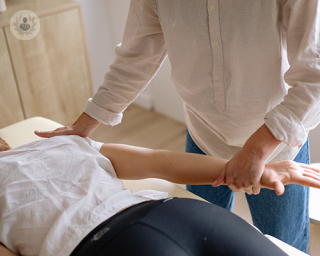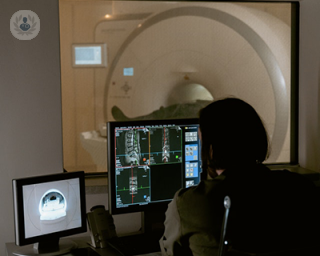Tendonitis
Mr Jordi Sanchez-Ballester - Orthopaedic surgery
Created on: 05-07-2018
Updated on: 04-20-2023
Edited by: Carlota Pano
What is tendonitis?
Tendonitis (also called tendinitis) refers to inflammation of a tendon. It is one of the major sub-types of tendinopathy (tendon disease), along with tendinosis and paratenonitis.
Tendons are thick, fibrous cords of tissue that attach muscles to bones. They are tough, yet flexible, and have evolved to withstand tension. However, they can become injured or strained due to overuse, leading to inflammation.
Common types of tendonitis include:
- Achilles tendonitis - affects the Achilles tendon in the heel.
- Supraspinatus tendinitis - affects the tendon around the top of the shoulder joint.
- Tennis elbow - or lateral epicondylitis. Causes pain on the outer elbow, which may radiate down towards the wrist.
- Golfer’s elbow - or medial epicondylitis. Causes pain on the inner elbow, which may radiate down to the wrist.
- Tendonitis of the wrist - affects people who make repetitive motions with their wrists, such as badminton players and production line workers.
- Trigger finger - the affected digit becomes fixed in a bent position due to a thickened and inflamed tendon, and will usually click when forced to straighten.
- Calcific tendonitis - calcium deposits build up in the tendon, causing pain. This most commonly occurs in the shoulder, but it can also occur in any tendon.
Tendonitis is related to, and often goes hand-in-hand with, tenosynovitis (inflammation of the sheath around the tendon, such as De Quervain syndrome).
What are the symptoms of tendonitis?
There are many symptoms that patients with tendonitis present with. The main, typical symptoms of tendonitis include:
- Pain, which may worsen during movement
- Swelling, redness, and heat
- A grating or crackling feeling when the tendon is moving
- A lump on the tendon
Symptoms occur when the tendon connects to the bone. They may last anywhere between a few days and several months. Without proper treatment, the condition can develop into chronic tendonosis and can leave the patient more susceptible to ruptures in the tendon.
What causes tendonitis?
There are two main direct causes of tendonitis: sudden injury and repetitive movements over time. These repetitive movements could be anything from movements made during activities like gardening, painting or cleaning to sports, such as tennis or golf. Bad posture and not warming up properly before exercise can also lead to tendonitis.
How can tendonitis be prevented?
There are a number of things one can do to prevent an onset of tendonitis. The main preventative measures include the following:
- Exercise - in order to prevent tendonitis, it is important to keep your muscles and tendons as strong and as flexible as possible
- It is equally important not to push yourself too hard, as overloading the muscles with more than they can handle is a prime cause of tendonitis
- Stretch before and after exercise to warm up and cool down
- Avoid repetitive movement

How is tendonitis treated?
The first line of treatment for mild tendonitis is usually RICE therapy for two to three days. This comprises of:
- Rest - avoid exercise or activity with the tendon until the injury improves.
- Ice - apply cold to the tendon for 15 to 20 minutes.
- Compress - wrap a bandage around it.
- Elevate - keep the injured area raised on a pillow when lying down.
It is recommended that you avoid heat, alcohol and massages for the first few days after injury. If the injury is severe or lasts longer than a few days, you should see a doctor, who may recommend different treatments depending on the nature and the severity of the tendonitis.
The main different treatments for tendonitis include:
- Painkillers - NSAIDs, such as ibuprofen, are often the first line of treatment, offering pain relief and anti-inflammation.
- Steroid injections
- Shockwave therapy - it may be used to speed up healing, or it may be used to break down calcium deposits in the case of calcific tendonitis
- Surgery - in very severe cases, the doctor may recommend removing damaged tissue or calcium deposits, or repairing a rupture via surgery.
What are the associated risk factors?
Age, in fact, is the most common tendonitis-associated risk factor. As we age, our tendons lose their elasticity, and become less flexible and easier to injure or tear. Other risk factors include jobs involving repetitive movements, sport (particularly “weekend warriors”, who are relatively inactive during the week, but push themselves hard at the weekend), and certain health conditions, such as diabetes and rheumatoid arthritis, which seem to go hand-in-hand with a greater likelihood of developing tendonitis.
Are transdermal therapeutics creams recommended for patients with tendonitis?
Transdermal therapeutics pain creams can be highly effective when it comes to treating and reducing any tendonitis-related aching, stiffness, throbbing, and/or soreness.
How exactly do transdermal therapeutics creams work?
When a transdermal therapeutics cream is gently rubbed onto the most painful area(s), the cream gets to work immediately and acts as a quick and effective pain reliever.

If I have been prescribed a transdermal therapeutics cream, will I require any pills, surgery, or injections for my tendonitis?
One of the main benefits of using a transdermal therapeutics cream is that it serves as an ideal and equally effective alternative to pills, injections, and surgery.
How can I treat my tendonitis at home?
Patients who present with tendonitis are advised to do the following at home with the aim being to effectively manage their pain:
- Rest as much as possible, avoiding any movement of the tendon for up to two to three days
- Apply ice on the painful area for roughly 20 minutes every two to three hours
- Put an elastic bandage around the painful area
Which specialist treats tendonitis?
An orthopaedic surgeon is the specialist you will want to book a consultation with if you are seeking treatment for your tendonitis.
















